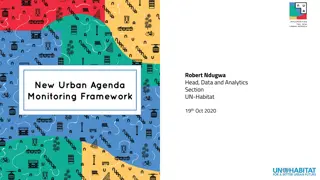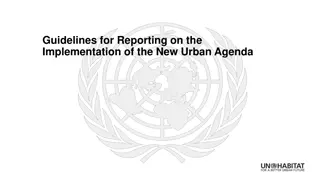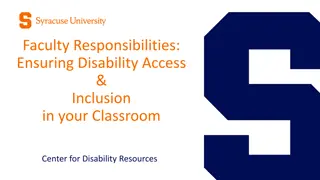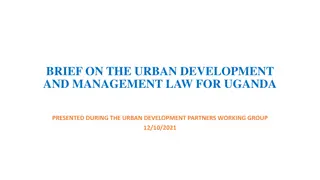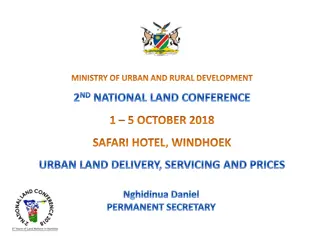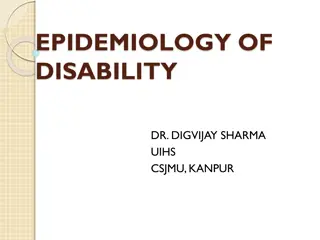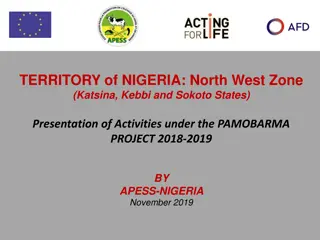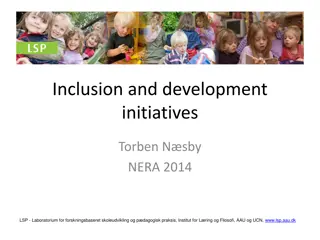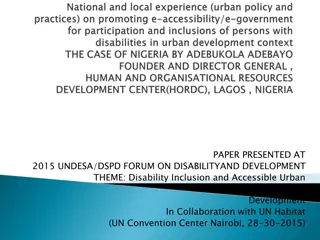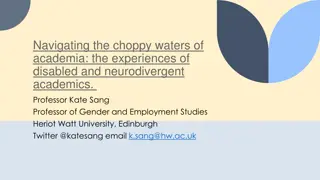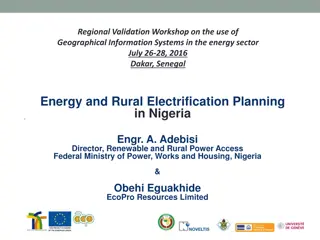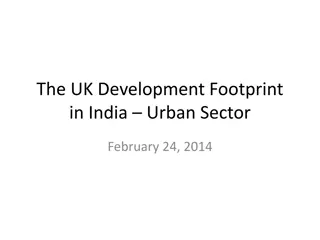Disability Inclusion in Urban Development: Challenges and Progress in Nigeria
The paper by Adebukola Adebayo explores the journey of disability inclusion in Nigeria, highlighting the shift from a medical charity approach to a rights-based perspective post the UN Convention on Rights of Persons with Disabilities in 2006. Despite progress, there is a lack of comprehensive legal frameworks for mainstreaming disability inclusion across sectors like transportation, housing, and health in the country.
Download Presentation

Please find below an Image/Link to download the presentation.
The content on the website is provided AS IS for your information and personal use only. It may not be sold, licensed, or shared on other websites without obtaining consent from the author.If you encounter any issues during the download, it is possible that the publisher has removed the file from their server.
You are allowed to download the files provided on this website for personal or commercial use, subject to the condition that they are used lawfully. All files are the property of their respective owners.
The content on the website is provided AS IS for your information and personal use only. It may not be sold, licensed, or shared on other websites without obtaining consent from the author.
E N D
Presentation Transcript
ADEBUKOLA ADEBAYO FOUNDER & DIRECTOR GENERAL, HUMAN AND ORGANIZATIONAL RESOURCES DEVELOPMENT CENTRE (HORDC), LAGOS, NIGERIA. PAPER PRESENTED AT: 2015 UNDESA/DSPD FORUM ON DISABILITY AND DEVELOPMENT Theme: Disability Inclusion and Accessible Urban Development In Collaboration With UN Habitat (UN Convention Center Nairobi, 28-30 Oct 2015)
The accessibility needs of persons with disabilities into laws, policies and programmes of government at national and sub-national levelsinNigeriaisrelativelynew. mainstreaming of inclusivity and
Before the commencement of Nigerias new democratic dispensation in 1999, disability issues was virtually treated as medical and charity issues. Therefore, government department disability was the Rehabilitationestablishedwithin nationaland stateministriesofsocialdevelopment. the charge only in of of Directorates
Even between 1999 and 2008, governments at national and sub-national levels in Nigeria hardly thought that disability had any connection with issues like physical planning and urban development let alone with sectors like transportation, housing, infrastructural development.Atbest,inNigeria,itwaseasier to link disability strictly and only with sectors likeeducationandhealth.
However, the situation began to change slightly upon the creation of the UN Convention on Rights of Persons with Disabilities in 2006 which sparked-off more advocacies by civil society groups and disabled people s organizations with support from major international partners and the eventual signing and ratification of the CRPDand its Optional Protocol in2010. development
At the moment, there are no national legal and policy frameworks which holistically guide the mainstreaming of inclusion and access of persons with disabilities across key sectors including physical planning and urban development as well as in key services like transportation, housing, health, education, etc.
Although a National Rehabilitation Policy is being implemented by the Federal Ministry of Women Affairs and Social Development with some broad multi-sectoral policy approach, evidences have shown that this task of inclusion and access for persons with disabilities has significantly overwhelmed a poorly staffed, poorly funded and incapacitated Directorate for Rehabilitation in theFederal and StateMinistries statutorily charged with the responsibility of ensuring inclusion of persons with disabilities in all laws, policies governmentwithin theirjurisdiction. and programmes of
GENERAL BACKGROUND CONTINUED In addition, Nigeria, like many other third world nations are faced with the huge challenge of poorly planned and constructed towns and cities (even for non-disabled populations) and infrastructural underdevelopment and deficits. Meaning that in the first place, the physical environment is generally poorly planned, inaccessible and lacks adequate infrastructure for the entire citizens including persons with disabilities.
GENERAL BACKGROUND CONTINUED Inaccessible Rough Terrain
GENERAL BACKGROUND CONTINUED Even when some form of town re-planning, city remodeling/renewal or infrastructural development/rehabilitati on takes place, there is apparent low awareness and low capacity on the part of public officials and civil servants to mainstream inclusivity and accessibility requirements and needs of persons with disabilities due to lack of legal and policy frameworks which would have provided regulations and guidelines.
In the absence of a holistic national initiative, some sub-national (state) governments are taking bold steps to promote and protect rights of persons with disabilities especially their inclusivity and accessibility rights and needs.
Between advocacies payed-off when the Lagos state government enacted the first and most comprehensivestate-level disability law, The Lagos State Special People s Law and established the Lagos State Office for Disability Affairs (LASODA) in 2012 to implementthelaw. 2010 and 2011, civil society
The creation of this legal framework in Lagos state heralded the beginning of what is now popularly regarded as the Inclusive Lagos .
The Lagos State Special Peoples Law provides for inclusion and access for persons with disabilities in virtually all spheres of life and sectors in the state: physical planning and urban development, development, housing, telecommunications, information, education, health, sports and recreation, employment, etc. infrastructural transportation,
In terms of physical planning and urban development,infrastructuraldevelopment/rehabi litation, housing, transportation and related matters, the law sets a five (5) year moratorium (between 2011 and government and all citizens should have fully complied with all inclusivity and accessibility requirements as prescribed in the Law; failure to which appropriate sanctions as prescribed in the law will be imposed. 2016) after which
The enactment of the Special Peoples Law in 2011 has influenced the review of other relevant laws especially the Planning and Urban Development Law which now provides a set of building codes which contains specific prescriptions for inclusivity and accessibility provisions in every public buildings and infrastructures including roads, pedestrian bridges, bus shelters, jetties, public car parks, eventsplacesand recreationcenters,etc. Lagos State Physical
SOME GOOD EXAMPLE S CONTINUED The first test case for the Lagos State Special People s Law was the redesigning construction of the new Lagos State House building in 2012 inclusivity and provisions for persons with disabilities. Afterwards, efforts have been on-going to ensure that the construction and rehabilitation of major public infrastructure in Lagos state complies with provisions of the Special People s Law and the Physical Planning and Urban Development law respectively. Other examples of compliance include: and of Assembly to make accessibility development, substantially
All new government and public buildings are built with substantial compliance with inclusivity and accessibility requirements;
SOME GOOD EXAMPLES CONTINUED Entrances to all government building the Secretariat have been rehabilitated and provided with ramps; within State
The state government managed mass transport scheme popularly called the Bus Rapid Transport (BRT) under the Lagos State Metropolitan Area Transport Authority (LAMATA) make provisions for accessible bus shelters and has just acquired accessible buses for persons with disabilities. Currently, Persons with disabilities are not charged any fees when they use the BRT.
ACCESSIBLE BUS Newly procured accessible Mass Transit Buses By LAMATA
The absence of an accurate disability data- base (DDB) in Lagos and Nigeria as a whole has made inclusive physical planning and urban development virtually difficult. The on- going National Identity Card scheme and the Continuous National processhavebothfailedto make Voters Registration
The case of Lagos state Residency Registration process when it commenced was similar. However, due to persistent advocacies in Lagos state, a proper provisions to effectively capture disability status of the citizens so as to make adequate provisions for them during planning. collaboration has been relevant MDAs, commencing the process to properlyregisterpersonswith disabilities. initiated between
The absence and inadequacy of enabling disability legal and remains a major challenge. This challenge is more obvious at the national level; as there are currently no policy direction, regulations andguidelinestocompelcompliance. policy frameworks
However, the Lagos state experience is being used as a success case study to stimulate similar developments in other states and at thefederallevel.
At the moment, disability bills have reached appreciable legislative levels in several other states while the national bill narrowly missed being signed into law during the last administration which ended in May 29th, 2015. Efforts are on-going to ensure that the new government gives assent to the bill which has been passed by the National Assembly.
The persistence of obvious public awareness and human capacity gaps have greatly limited the pace and quality of inclusive and accessible physical developmentinNigeria. planning and urban
The whole idea and practice of social inclusion and the mainstreaming of disability issues into the broad spectrum of socio- political, economic, technological, environmental and infrastructural activities is generally new in Nigeria.
TheentireNigerian public including actors on the supply side of policy are just virtually learning on the skills and methodologies of disability-based social inclusion. Due to Nigeria s peculiarities, the public awareness and processhasbeenlargelyslow. capacity building
However, the rising levels of civil society advocacies with support from international development partners is helping to step up public awareness and build capacities of all stakeholders.
Similarly, due to capacity gaps, there is a seeming lop-sidedness of physical planning and urban development activities towards physical disabilities while other disability types intellectual disabilities) are not adequately capturedinthedesignofprojects. projects and (blind, deaf and
For instance, blind and deaf persons are still confronted with the challenges of accessing public information on signages, road signs and maps, public utility user guides, etc. Also, accessibility needs of blind and deaf persons on roads, public buildings, etc are yet to be achieved.
Again, due to capacity and technology gaps, there is persistence in the challenge of accuracy and precision measurements of accessibility features of infrastructures such wheelchairaccessibledoor-ways,etc. especially in as ramp slopes,
The challenge of poor funding for disability projects have not been effectively overcome due to poor prioritization of disability issues. For instance, the use of accessible buses and trains are considered too expensive to acquireandmaintain.
DPOs and CSOs in Nigeria are mostly confronted with the challenges of funding and institutional capacities effective policy reviews, monitoring and evaluation, as well awareness. to sustain as massive public
Inclusive and accessible physical planning and urban development will not be achieved in holistic terms if we concentrate on efforts to mainstream inclusivity requirements into development of new towns,citiesandinfrastructures. and accessibility
SHORTCOMINGS There is urgent need to map out plans to rebuild or rehabilitate the vast very inaccessible existing towns, cities, infrastructure and services.
For instance, in Lagos state there are several roads, pedestrian bridges, public buildings, industrial and housing estates, transport services, etc which remodeling or rehabilitation to ensure that they are inclusive of, and accessible to personswithdisabilities. require rebuilding,
SHORTCOMINGS Inaccessible Rough Terrains and Open Drainage
SHORTCOMINGS All new roads and pedestrian bridges constructed and rehabilitated between 2012 till date are provided with ramps and accessible sidewalks;
It isobservedthatbeyondtheachievementof the enactment of a disability law and establishment of a disability agency in Lagos state,thereisneedtoadvocateforthe review of the Lagos state long term development planning instrument, Development Plan in which should be embedded a disability-inclusive accessibleUrbanDevelopmentMasterPlan. the State and
an development programme (especially in a country with high infrastructural deficit and highly distorted urban planning like Nigeria) is highly capital intensive. It will therefore require the setting-up of a Special Fund drawn from international agencies, private sector and the budget of thestategovernment. inclusive and accessible urban development
Similarly, from the Lagos state experience in Nigeria, it is observed that governments in poor countries may appear reluctant to expend so much to rebuild or remodel infrastructure and cities just to enhance inclusionandaccessibilityforPWDs.
As such, beyond the conduct of advocacies, innovative and strategic approaches are required to identify cost effective methods of inclusive and accessible urban development in poor countries.
The inclusive and accessible physical planning and urban development in Nigeria exposes the twoevidentialextremes: local and national experiences of
where the absence or inadequacy of legal and policy frameworks at the national level is denying persons with disabilities their right to an inclusive and accessible environment .
and the case where at the sub-national level, the availability of legal and policy framework is helping to drive the growth of an inclusive andaccessiblecity.
This experience point to the fact that legal, policy and institutional frameworks are key requirements to effectively drive and sustain inclusive practices rebuilding and rehabilitation of new and existing towns, cities, infrastructure and services for the benefit of persons with disabilities. in the development,
Once the major legal, policy and institutional issues are resolved, the more specific issues with low public awareness and low human capacitywillbesubstantiallyresolved.





